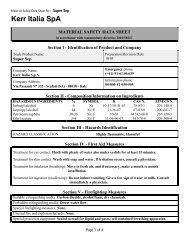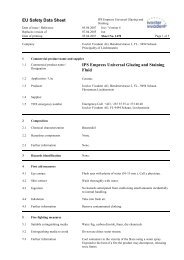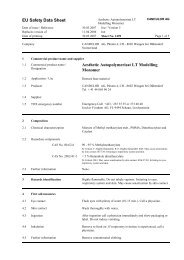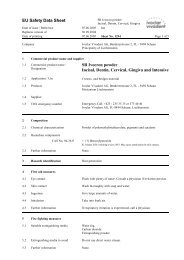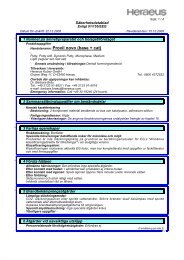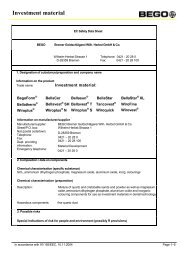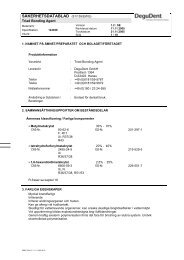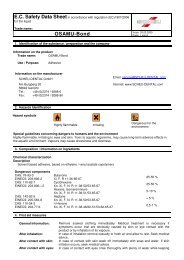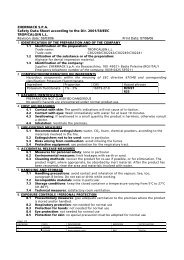Fluxsol MSDS - Bego USA
Fluxsol MSDS - Bego USA
Fluxsol MSDS - Bego USA
Create successful ePaper yourself
Turn your PDF publications into a flip-book with our unique Google optimized e-Paper software.
<strong>Fluxsol</strong><br />
Safety Data Sheet<br />
EC Safety Data Sheet<br />
BEGO<br />
Bremer Goldschlägerei Wilh. Herbst GmbH & Co.<br />
Wilhelm-Herbst-Strasse 1 Tel.: +49 (0)421 - 20 28-0<br />
D-28359 Bremen Fax: +49 (0)421 - 20 28-100<br />
Germany<br />
1. Product and company identification<br />
Tel. no. in case of emergency: +49 (0)421 - 20 28 0<br />
Data on product<br />
Name of product:<br />
<strong>Fluxsol</strong><br />
Data on manufacturer/supplier<br />
Manufacturer/supplier:<br />
BEGO Bremer Goldschlägerei Wilh. Herbst GmbH & Co.<br />
Street/P.O. box: Wilhelm-Herbst-Strasse 1<br />
Nat. postal code/town:<br />
D-28359 Bremen<br />
Country:<br />
Germany<br />
Tel. no.: +49 (0)421 - 20 28-0<br />
Fax no.: +49 (0)421 - 20 28-100<br />
Dept. providing information: Material Development<br />
Emergency tel. no.: +49 (0)421 - 20 28-0<br />
2. Composition / information on components<br />
Chemical characterization of specific substance<br />
Designation CAS No. EC No. EC Index No.<br />
Potassium hydrogen difluoride 7789-29-9 232-156-2 009-008-00-9<br />
Ethylene glycol 107-21-1 203-473-3 603-027-00-1<br />
Component Hazard symbols R provisions Total formula<br />
Potassium hydrogen difluoride T, C R 25-34 F2HK<br />
Ethylene glycol Xn R 22 C2H6O2<br />
Chemical characterization of product<br />
Description:<br />
Hazardous components:<br />
Complex mixture, contains potassium hydrogen difluoride and ethylene glycol<br />
potassium hydrogen difluoride (potassium bifluoride, hydrogen potassium<br />
fluoride, potassium acid fluoride)<br />
ethylene glycol (ethandiol)<br />
Component Concentration Hazard symbols R provisions<br />
In accordance with 91/155/EEC, 20.12.2002 Page 1 of 8
<strong>Fluxsol</strong><br />
Potassium hydrogen difluoride < 5% C R 22-34<br />
Ethylene glycol 1% - -<br />
3. Possible risks<br />
Designation of hazards<br />
Hazard identification: C caustic<br />
Xn harmful to health<br />
Special indications of risk for people and environment<br />
Causes acid burns. Harmful to health if swallowed.<br />
Specific risks<br />
Possible harmful impact on people and possible symptoms:<br />
Acid burns must be treated immediately, otherwise wounds that are difficult to heal result. Skin contact and<br />
inhalation of aerosols/vapours of the preparation should be avoided. During work wear suitable protective<br />
clothing, safety gloves and safety goggles / face screen.<br />
4. First aid measures<br />
General instructions<br />
Call in physician immediately. In case of risk of unconsciousness, place and transport person in a lateral<br />
recovery position. Remove dirty, soaked clothing immediately. In the event of contact with the eyes, rinse<br />
thoroughly with water and consult a physician. In the case of an accident or indisposition, call in a physician at<br />
once (if possible, show this label). In case of cessation of breathing, place person on back, overstretch head,<br />
mouth-to-nose respiration. Do not carry out mouth-to-mouth respiration.<br />
After inhalation<br />
Remove person to fresh air at once. In case of cessation of breathing, carry out artificial respiration. In event<br />
of difficulty with breathing, administration of oxygen if necessary. Keep person warm. Have person rest. Call<br />
in physician immediately.<br />
After skin contact<br />
In case of contact with the skin, wash off with plenty of water for at least 15 minutes. Dab with polyethylene<br />
glycol 400. Remove contaminated clothing at once. In any case call in physician. Acid burns that are not<br />
treated lead to wounds that are difficult to heal.<br />
After eye contact<br />
In the event of contact with the eyes, rinse eyes under running water with eyelids open for at least 15<br />
minutes. Consult an eye doctor at once.<br />
After swallowing<br />
Do not induce vomiting. Immediately rinse mouth thoroughly with water. Have person drink plenty of water (at<br />
least 0.5 l) in small sips (dilution effect). Obtain medical assistance at once. Rest, warmth, place and<br />
transport person in lateral recovery position.<br />
Remove contaminated clothing while rinsing continuously with plenty of water.<br />
Symptoms of acid burns may not emerge until many hours later, therefore medical supervision for at least 48<br />
hours after accident.<br />
In accordance with 91/155/CEE, 20.12.2002 Page 2 of 8
<strong>Fluxsol</strong><br />
5. Fire-fighting measures<br />
Suitable extinguishing agents<br />
CO 2 , fire extinguishing powder, water spray or foam. Adapt fire-fighting measures to surroundings. Suppress<br />
vapours with spray jet.<br />
Special risk due to substance or the product itself, its products of combustion or resulting gases, further<br />
information<br />
The product itself is not combustible. Hazardous vapours may form due to ambient fire. In the event of fire,<br />
hydrogen fluoride (HF) may be released. In case of contact with light metals, hydrogen gas may form (risk of<br />
explosion).<br />
Special protective equipment for fire fighting<br />
Use suitable breathing apparatus that is independent of ambient air. Use protective clothing for fire-fighting so<br />
as to avoid skin and eye contact. Stay in the danger zone only with suitable, impervious chemical protection<br />
suit.<br />
Other instructions<br />
Avoid penetration of fire-fighting water in surface waters or groundwater.<br />
6. Measures in the event of unintentional release<br />
Personal precautionary measures<br />
Avoid contact with substance. Do not pick up with unprotected hands. Wear protective clothing in accordance<br />
with section 8 of this safety data sheet.<br />
Environmental protection measures<br />
Do not allow to enter sewer system or waterbodies.<br />
Cleaning/collection procedure<br />
Collect mechanically with liquid-binding material (e.g. sand, clay mineral, diatomaceous earth, vermiculite,<br />
universal binder). Put leaky receptacles, residues and contaminated material in identified and sealable<br />
containers. If necessary, clean again. Disposal as waste in accordance with section 13 of this safety data<br />
sheet.<br />
7. Handling and storage<br />
Handling – instructions for safe handling<br />
Only use in well ventilated areas. Keep work area well ventilated when soldering. Suction-extract and<br />
discharge safely vapours/aerosols directly at the site of generation. Do not allow paste to dry out. Avoid<br />
contact with eyes and skin. Do not inhale gas/smoke/vapour/aerosol.<br />
Handling – instructions regarding fire and explosion protection<br />
The product is not combustible. Keep away from ignition sources – do not smoke.<br />
Storage – storeroom and container requirements<br />
Keep under lock and key. Keep containers tightly sealed and store in a cool, dry and well ventilated place.<br />
Unsuitable material for containers/equipment: aluminium, tin or zinc. VCI storage class: LGK8BS – Noncombustible<br />
caustic substances (solid).<br />
In accordance with 91/155/CEE, 20.12.2002 Page 3 of 8
<strong>Fluxsol</strong><br />
8. Exposure control and personal protective equipment<br />
Components with workplace-related or biological limit values that must be monitored<br />
TRGS 900 (maximum permissible workplace concentration – MPWC):<br />
Scope of application: fluorides (calculated as fluorine)<br />
MPWC of fluorides: 2.5 mg/m 3 breathable dust portion<br />
Peak limitation:<br />
excess factor 4 (The mean concentration shall not exceed the fourfold limit<br />
concentration in any 15-minute period.)<br />
Limitation and monitoring of exposure<br />
See section 7. No measures beyond that are necessary.<br />
Personal protective equipment<br />
Respiratory protection<br />
Respiratory protection is necessary if there is increased concentration in the air and dust is generated.<br />
Type of mask: full mask (DIN EN 136) or half-mask (DIN EN 140).<br />
Respiratory protection filter: filter class E 2 (acid gases) or P2 (particles).<br />
Hand protection<br />
Use solvent-resistant safety gloves made of NBR (nitrile rubber) or butyl (butyl rubber) with at least 10 cm<br />
long sleeve.<br />
Eye protection<br />
Tightly sealing safety goggles with lenses made of safety glass.<br />
Body protection<br />
Wear acid-resistant, impervious protective work clothing. Protective aids for the body are to be selected<br />
depending on the concentration and amount of hazardous substance and according to the specific<br />
workplace. Pay attention to chemical resistance of the protective aids (suppliers).<br />
General safety and hygienic measures<br />
Avoid contact with eyes, skin and clothing. Remove contaminated and/or soaked clothing at once. Keep away<br />
from food. Do not eat, drink, smoke or take snuff during work. Wash hands before breaks and at the end of<br />
work. Preventive skin protection by means of protective skin ointment. Further suitable skin care measures<br />
according to code of practice “Skin protection” of the employer’s liability insurance association (e.g. BG<br />
Chemie [employer’s liability insurance association for chemical industry] No. M 042). Minimum standards for<br />
protective measures when handling working substances are listed in TRGS 500 (Technical Rules for<br />
Hazardous Substances).<br />
9. Physical and chemical properties<br />
Non-combustible, pasty solid. Soluble in water. Hygroscopic in dry state. Aqueous solution has acidic<br />
reaction. The solution with potassium hydrogen difluoride has a more corrosive effect than that with<br />
potassium fluoride.<br />
Appearance<br />
State:<br />
Colour:<br />
Odour:<br />
pasty, viscous<br />
white<br />
odourless<br />
In accordance with 91/155/CEE, 20.12.2002 Page 4 of 8
<strong>Fluxsol</strong><br />
Important data on health and environmental protection and on safety<br />
pH value:<br />
5.3 (50% aqueous solution)<br />
Flash point:<br />
not applicable<br />
Explosion limits:<br />
not applicable<br />
Density.<br />
1.6 g/cm 3 (20°C)<br />
Aqueous solubility:<br />
can be mixed without restriction<br />
Melting temperature Density<br />
Potassium hydrogen difluoride 239°C 2.37 g/cm 3<br />
10. Stability and reactivity<br />
Conditions to be avoided<br />
Do not allow paste to dry out. No further data available.<br />
Substances to be avoided<br />
Materials containing glass and silicate are corroded. In case of contact with strong acids: formation of<br />
hydrogen fluoride. Pay attention to pungent odour!<br />
Hazardous decomposition products<br />
No decomposition given proper use. Reaction with strong acids: formation of hydrogen fluoride. Suctionextract<br />
vapours and discharge safely. Decomposition products in event of fire: see section 5.<br />
Further information<br />
Dry product is hygroscopic. Incompatible with metals, various plastics, glass, animal/plant fibres.<br />
11. Toxicological information<br />
The product has a caustic and harmful effect on the mucous membranes of the eyes and the respiratory<br />
organs. In the event of skin injuries and mucous membrane contact, toxic and caustic effect must be<br />
expected; if swallowed, damage in the gastrointestinal tract and intoxication must be expected. Harmful if<br />
swallowed, inhaled or in the case of contact with the skin. The main component, potassium hydrogen<br />
difluoride, poses acute or chronic risks to health.<br />
Further toxicological information<br />
After inhalation<br />
Causes acid burns to the mucous membrane and may be harmful if inhaled. Inhalation may lead to spasms,<br />
inflammation and oedema of larynx and bronchial tubes, chemical pneumonia and pulmonary oedema.<br />
Extremely damaging effect on the tissue of the mucous membranes and upper respiratory tracts as well as<br />
on eyes and skin.<br />
After skin contact<br />
Causes acid burns and may be harmful in the event of intake via the skin.<br />
After eye contact<br />
Causes acid burns. Risk of corneal clouding. Risk of blindness!<br />
After swallowing<br />
Causes acid burns and is harmful if swallowed in the mouth, throat, oesophagus and gastrointestinal tract.<br />
In accordance with 91/155/CEE, 20.12.2002 Page 5 of 8
<strong>Fluxsol</strong><br />
Tissue damage. Risk of perforation for oesophagus and stomach. In the event of intake of large amounts of<br />
potassium ions, risk of reduction in blood pressure, coma and death.<br />
After resorption<br />
Heat sensation, spasms, coughing, headache, cardiac dysrhythmia, shock, unconsciousness. If allowed to<br />
react for a longer period: damage to bone marrow. For soluble inorganic fluorides the following generally<br />
applies: Contact with eyes, skin and mucous membranes leads to irritation or even acid burns. Symptoms of<br />
excessive exposure to fluorides are salivation, nausea, vomiting, abdominal pains, fever, shortness of breath<br />
and cessation of breathing. Systemic effect of fluoride ions: reduction of blood serum-calcium level with risk<br />
of fatal hypocalcaemia, excitation, spasms, cardiovascular disorders, central nervous system disorders.<br />
Exposure to fluoride dust, vapours or mist for a longer period leads to perforation of the nasal septum.<br />
Chronic effects include excessive calcification of the bones, ligaments and tendons.<br />
Organs affected<br />
Kidneys, heart, bones, nerves, gastrointestinal tract, teeth<br />
Further information<br />
The product must be handled with special care.<br />
12. Ecological information<br />
Ecotoxic effects<br />
Harmful effect on water organisms. Toxic effect on fish and plankton. Harmful effect due to pH shift. In spite<br />
of dilution, still forms caustic mixtures with water. Does not cause any biological oxygen depletion.<br />
Neutralization possible in treatment plants. Hazardous for drinking water. Do not allow to enter waterbodies,<br />
sewer system or soil!<br />
Biological effects – data for potassium fluoride<br />
Fish toxicity: fish LC50 > 2.3 mg/l<br />
Protozoa Entosiphon sulcatum EC 5 : 101 mg/l<br />
Further ecological information<br />
Biological effects for inorganic fluorides (all data as sodium fluoride):<br />
Fish toxicity: L. idus LC50 = 660 mg/L<br />
Bacterial toxicity: Ps. putida toxic from 231 mg/l and up<br />
Algae toxicity: Sc. quadricauda toxic from 249 mg/l and up<br />
Protozoa toxicity: E. sulcatum toxic from 101 mg/l and up<br />
U. parduzczi toxic from 71 mg/l and up<br />
Biological degradability<br />
Methods for determination of biodegradability are not applicable for inorganic substances.<br />
Behaviour in the environment<br />
Accumulation in organisms is not expected.<br />
13. Disposal considerations<br />
Product<br />
Uniform regulations on disposal of chemicals in the Member States of the EU do not exist. In Germany the<br />
requirement of recycling is stipulated by the Closed Substance Cycle and Waste Management Act. The<br />
In accordance with 91/155/CEE, 20.12.2002 Page 6 of 8
<strong>Fluxsol</strong><br />
waste producer has to differentiate between “wastes for recycling” and “wastes for disposal” and carry out<br />
waste determination according to defined rules. This determination is geared to the material characteristics<br />
and in particular to the origin of the wastes. Furthermore, additional special features regarding the<br />
implementation of disposal are regulated by the German Länder. It is recommended that contact be made<br />
with the authorities and/or waste management companies and further information be obtained on recycling or<br />
disposal.<br />
Waste regulations according to Ordinance on the List of Wastes (AVV)<br />
Due to the hazardous components, the wastes require special monitoring. Accountability for disposal.<br />
Proposals for waste determination:<br />
Waste group 06 01<br />
Waste group 11 01<br />
Waste group 16 05<br />
Wastes from production, preparation, distribution and use of acids<br />
Wastes from chemical surface treatment and coating of metals and other materials<br />
(e.g. electroplating, galvanized coating, pickling, etching, phosphatizing, alkaline<br />
degreasing and electrolytic oxidation)<br />
Gases in pressure vessels and used chemicals<br />
Waste key<br />
Waste designation<br />
06 01 06* other acids<br />
11 01 05* acid pickling solutions<br />
11 01 06* acids not otherwise specified<br />
11 01 98* other wastes that contain hazardous substances<br />
16 05 06* laboratory chemicals that consist of or contain hazardous substances, including<br />
mixtures of laboratory chemicals<br />
16 05 07* used inorganic chemicals that consist of or contain hazardous substances<br />
Packaging<br />
Disposal according to the provisions of the waste law. Packaging contaminated with the product is<br />
considered to be waste requiring special monitoring.<br />
Waste key<br />
Waste designation<br />
15 01 10* Packaging that contains residues of hazardous substances or is contaminated with<br />
hazardous substances.<br />
If not expressly stipulated, non-contaminated packaging can be recycled without documentary proof.<br />
14. Transport information<br />
Overland transport: Road transport ADR/GGVSE and rail transport RID/GGVSE<br />
UN no.: 1811<br />
Designation of product:<br />
POTASSIUM HYDROGEN DIFLUORIDE, MIXTURE<br />
Class: 8<br />
Classification code:<br />
CT2<br />
Packaging group:<br />
II<br />
Hazard label: 8 + 6.1<br />
Hazard identification no.: 86<br />
Remark:<br />
Product is pasty in accordance with 2.3.4 ADR/RID<br />
Inland shipping transport (ADNI/ADNR)<br />
UN no.: 1811<br />
Designation of product:<br />
POTASSIUM HYDROGEN DIFLUORIDE, MIXTURE<br />
In accordance with 91/155/CEE, 20.12.2002 Page 7 of 8
<strong>Fluxsol</strong><br />
Class: 8<br />
Classification code:<br />
CT2<br />
Packaging group:<br />
II<br />
Hazard label: 8 + 6.1<br />
Remark:<br />
Product is pasty in accordance with 2.3.4 ADR/RID<br />
Maritime shipping transport (IMDG code)<br />
UN no.: 1811<br />
Proper Shipping Name:<br />
POTASSIUM HYDROGEN DIFLUORIDE, SOLID, MIXTURE<br />
Class: 8<br />
Packaging group:<br />
II<br />
EmS no.: 8-06<br />
Marine pollutant:<br />
No<br />
Hazard identification: 8 + 6.1<br />
Remark:<br />
Product is pasty in accordance with 2.3.4 ADR/RID (not a liquid<br />
substance in accordance with 1.2.1 IMDG code)<br />
Air transport (ICAO-TI/IATA-DGR)<br />
UN / ID no.: 1811<br />
Designation of product:<br />
POTASSIUM HYDROGEN DIFLUORIDE, SOLID, MIXTURE<br />
Proper Shipping Name:<br />
RESIN POTASSIUM HYDROGEN DIFLUORIDE, SOLID, MIXTURE<br />
Class: 8<br />
Packaging group:<br />
II<br />
Hazard identification:<br />
corrosive (RCM), toxic (RPB)<br />
Remark:<br />
Product is pasty in accordance with 2.3.4 ADR/RID (not a liquid<br />
substance in accordance with Annex A IATA-DGR)<br />
Further information<br />
The product is not approved for postal delivery.<br />
15. Regulatory information<br />
The product was classified according to the specifications of the Dangerous Substance Directive (EC<br />
Directive 67/548/EEC, Annex I). Hazard-determining component for labelling: potassium hydrogen difluoride<br />
(caustic C; toxic T).<br />
Labelling according to EC directives<br />
Hazard symbols: C caustic<br />
R provisions: R 34 Causes acid burns.<br />
R 22 Harmful if swallowed.<br />
S provisions: S 1/2 Keep under lock and key such that inaccessible to children (if<br />
designed for the general public).<br />
S 22 Do not inhale dust.<br />
S 26 In the event of contact with the eyes, rinse thoroughly with water at<br />
once and consult a physician.<br />
S 37 Wear suitable safety gloves.<br />
S 45 In event of accident or indisposition call in physician immediately<br />
(show this label if possible).<br />
German regulations<br />
In accordance with 91/155/CEE, 20.12.2002 Page 8 of 8
<strong>Fluxsol</strong><br />
The national legal regulations must additionally be observed!<br />
Employment restriction:<br />
Hazardous Incident Ordinance:<br />
Classification acc. to VbF:<br />
Clean Air Directive:<br />
Water hazard class:<br />
Comply with Section 22 of Youth Employment Protection Law (JarbSchG)<br />
and Section 5 of Maternity protection Guideline Regulation (MuSchRiV)!<br />
Product is not subject to Hazardous Incident Ordinance.<br />
Product is not subject to VbF.<br />
Not applicable.<br />
WGK 1 (low degree of water endangerment)<br />
classification of the components in accordance with Administrative<br />
Regulation on the Classification of Substances Hazardous to Waters<br />
(VwVwS), Annex 2<br />
potassium hydrogen difluoride (identification no. 342: WGK 1)<br />
Other national regulations<br />
Swiss toxin class: 3<br />
Miscellaneous regulations, restrictions and prohibitory regulations<br />
VCI storage class:<br />
LGK8BS – Non-combustible caustic substances (solid)<br />
BG-Chemie codes of practice: M004 Irritating substances / caustic substances<br />
M005 Hydrogen fluoride, hydrofluoric acid and inorganic fluorides<br />
M050 Handling harmful substances<br />
M051 Hazardous chemical substances<br />
Application restrictions:<br />
The product may be used exclusively as a flux for soldering dental alloys<br />
in the dental laboratory.<br />
16. Other information<br />
Data sheet issued by:<br />
Material Development Department<br />
Contact person:<br />
Dr. Thomas Wiest<br />
Reasons for change:<br />
Complete revision<br />
Revised on: 20.12.2002<br />
Replaces issue dated: 22.11.1999<br />
The data are based on the current level of our knowledge. They are intended in particular to describe our<br />
product with regard to the hazards related to its use and the safety precautions to be taken. They do not<br />
represent any guarantee of product and quality characteristics.<br />
In accordance with 91/155/CEE, 20.12.2002 Page 9 of 8



